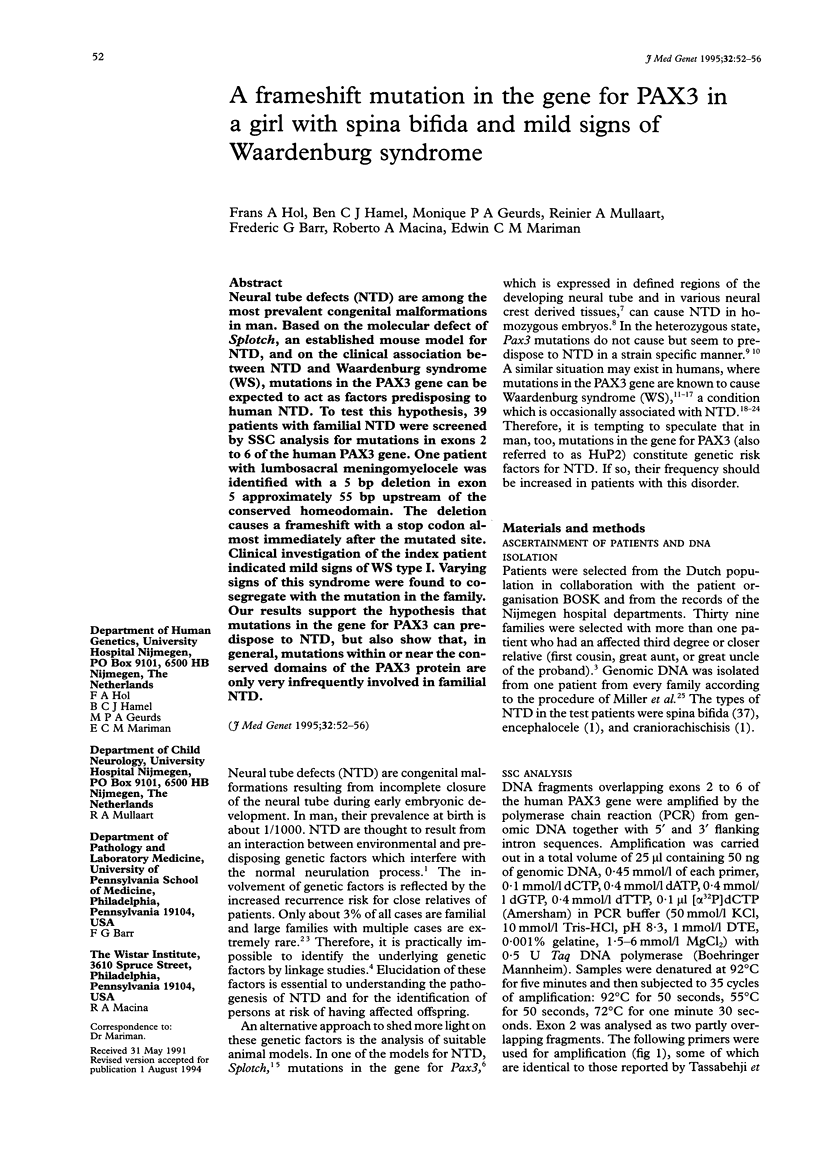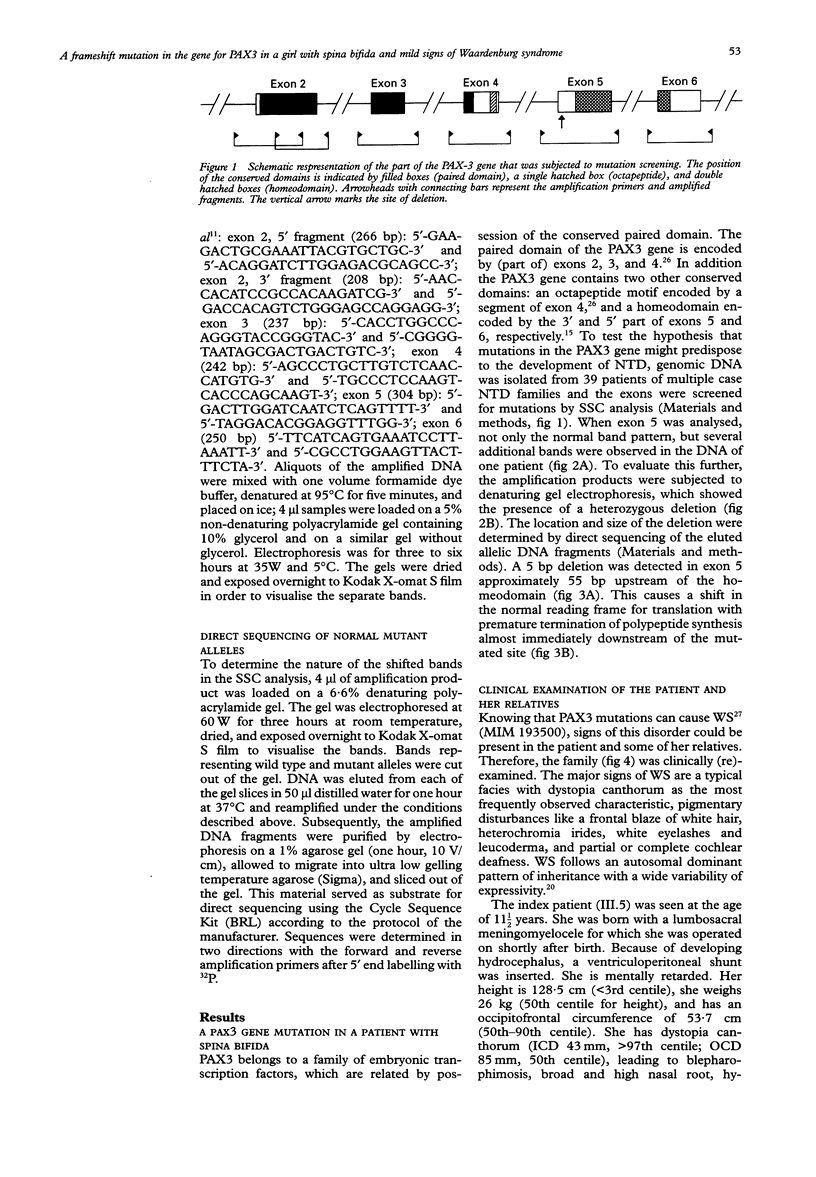Abstract
Neural tube defects (NTD) are among the most prevalent congenital malformations in man. Based on the molecular defect of Splotch, an established mouse model for NTD, and on the clinical association between NTD and Waardenburg syndrome (WS), mutations in the PAX3 gene can be expected to act as factors predisposing to human NTD. To test this hypothesis, 39 patients with familial NTD were screened by SSC analysis for mutations in exons 2 to 6 of the human PAX3 gene. One patient with lumbosacral meningomyelocele was identified with a 5 bp deletion in exon 5 approximately 55 bp upstream of the conserved homeodomain. The deletion causes a frameshift with a stop codon almost immediately after the mutated site. Clinical investigation of the index patient indicated mild signs of WS type I. Varying signs of this syndrome were found to cosegregate with the mutation in the family. Our results support the hypothesis that mutations in the gene for PAX3 can predispose to NTD, but also show that, in general, mutations within or near the conserved domains of the PAX3 protein are only very infrequently involved in familial NTD.
Full text
PDF




Images in this article
Selected References
These references are in PubMed. This may not be the complete list of references from this article.
- Baldwin C. T., Hoth C. F., Amos J. A., da-Silva E. O., Milunsky A. An exonic mutation in the HuP2 paired domain gene causes Waardenburg's syndrome. Nature. 1992 Feb 13;355(6361):637–638. doi: 10.1038/355637a0. [DOI] [PubMed] [Google Scholar]
- Begleiter M. L., Harris D. J. Waardenburg syndrome and meningocele. Am J Med Genet. 1992 Nov 1;44(4):541–541. doi: 10.1002/ajmg.1320440434. [DOI] [PubMed] [Google Scholar]
- Burri M., Tromvoukis Y., Bopp D., Frigerio G., Noll M. Conservation of the paired domain in metazoans and its structure in three isolated human genes. EMBO J. 1989 Apr;8(4):1183–1190. doi: 10.1002/j.1460-2075.1989.tb03490.x. [DOI] [PMC free article] [PubMed] [Google Scholar]
- Butt J., Greenberg J., Winship I., Sellars S., Beighton P., Ramesar R. A splice junction mutation in PAX3 causes Waardenburg syndrome in a South African family. Hum Mol Genet. 1994 Jan;3(1):197–198. doi: 10.1093/hmg/3.1.197. [DOI] [PubMed] [Google Scholar]
- Carezani-Gavin M., Clarren S. K., Steege T. Waardenburg syndrome associated with meningomyelocele. Am J Med Genet. 1992 Jan 1;42(1):135–136. doi: 10.1002/ajmg.1320420127. [DOI] [PubMed] [Google Scholar]
- Chalepakis G., Stoykova A., Wijnholds J., Tremblay P., Gruss P. Pax: gene regulators in the developing nervous system. J Neurobiol. 1993 Oct;24(10):1367–1384. doi: 10.1002/neu.480241009. [DOI] [PubMed] [Google Scholar]
- Chatkupt S., Chatkupt S., Johnson W. G. Waardenburg syndrome and myelomeningocele in a family. J Med Genet. 1993 Jan;30(1):83–84. doi: 10.1136/jmg.30.1.83. [DOI] [PMC free article] [PubMed] [Google Scholar]
- Chatkupt S., Lucek P. R., Koenigsberger M. R., Johnson W. G. Parental sex effect in spina bifida: a role for genomic imprinting? Am J Med Genet. 1992 Nov 1;44(4):508–512. doi: 10.1002/ajmg.1320440426. [DOI] [PubMed] [Google Scholar]
- Copp A. J., Brook F. A., Estibeiro J. P., Shum A. S., Cockroft D. L. The embryonic development of mammalian neural tube defects. Prog Neurobiol. 1990;35(5):363–403. doi: 10.1016/0301-0082(90)90037-h. [DOI] [PubMed] [Google Scholar]
- Epstein D. J., Vekemans M., Gros P. Splotch (Sp2H), a mutation affecting development of the mouse neural tube, shows a deletion within the paired homeodomain of Pax-3. Cell. 1991 Nov 15;67(4):767–774. doi: 10.1016/0092-8674(91)90071-6. [DOI] [PubMed] [Google Scholar]
- Estibeiro J. P., Brook F. A., Copp A. J. Interaction between splotch (Sp) and curly tail (ct) mouse mutants in the embryonic development of neural tube defects. Development. 1993 Sep;119(1):113–121. doi: 10.1242/dev.119.1.113. [DOI] [PubMed] [Google Scholar]
- Hol F. A., Geurds M. P., Jensson O., Hamel B. C., Moore G. E., Newton R., Mariman E. C. Exclusion mapping of the gene for X-linked neural tube defects in an Icelandic family. Hum Genet. 1994 Apr;93(4):452–456. doi: 10.1007/BF00201674. [DOI] [PubMed] [Google Scholar]
- Hoth C. F., Milunsky A., Lipsky N., Sheffer R., Clarren S. K., Baldwin C. T. Mutations in the paired domain of the human PAX3 gene cause Klein-Waardenburg syndrome (WS-III) as well as Waardenburg syndrome type I (WS-I). Am J Hum Genet. 1993 Mar;52(3):455–462. [PMC free article] [PubMed] [Google Scholar]
- Mariman E. C., Hamel B. C. Sex ratios of affected and transmitting members of multiple case families with neural tube defects. J Med Genet. 1992 Oct;29(10):695–698. doi: 10.1136/jmg.29.10.695. [DOI] [PMC free article] [PubMed] [Google Scholar]
- Miller S. A., Dykes D. D., Polesky H. F. A simple salting out procedure for extracting DNA from human nucleated cells. Nucleic Acids Res. 1988 Feb 11;16(3):1215–1215. doi: 10.1093/nar/16.3.1215. [DOI] [PMC free article] [PubMed] [Google Scholar]
- Moase C. E., Trasler D. G. Splotch locus mouse mutants: models for neural tube defects and Waardenburg syndrome type I in humans. J Med Genet. 1992 Mar;29(3):145–151. doi: 10.1136/jmg.29.3.145. [DOI] [PMC free article] [PubMed] [Google Scholar]
- Moline M. L., Sandlin C. Waardenburg syndrome and meningomyelocele. Am J Med Genet. 1993 Aug 1;47(1):126–126. doi: 10.1002/ajmg.1320470130. [DOI] [PubMed] [Google Scholar]
- Morell R., Friedman T. B., Asher J. H., Jr A plus-one frameshift mutation in PAX3 alters the entire deduced amino acid sequence of the paired box in a Waardenburg syndrome type 1 (WS1) family. Hum Mol Genet. 1993 Sep;2(9):1487–1488. doi: 10.1093/hmg/2.9.1487. [DOI] [PubMed] [Google Scholar]
- Morell R., Friedman T. B., Moeljopawiro S., Hartono, Soewito, Asher J. H., Jr A frameshift mutation in the HuP2 paired domain of the probable human homolog of murine Pax-3 is responsible for Waardenburg syndrome type 1 in an Indonesian family. Hum Mol Genet. 1992 Jul;1(4):243–247. doi: 10.1093/hmg/1.4.243. [DOI] [PubMed] [Google Scholar]
- Narod S. A., Siegel-Bartelt J., Hoffman H. J. Cerebellar infarction in a patient with Waardenburg syndrome. Am J Med Genet. 1988 Dec;31(4):903–907. doi: 10.1002/ajmg.1320310424. [DOI] [PubMed] [Google Scholar]
- Tassabehji M., Read A. P., Newton V. E., Harris R., Balling R., Gruss P., Strachan T. Waardenburg's syndrome patients have mutations in the human homologue of the Pax-3 paired box gene. Nature. 1992 Feb 13;355(6361):635–636. doi: 10.1038/355635a0. [DOI] [PubMed] [Google Scholar]
- Tassabehji M., Read A. P., Newton V. E., Patton M., Gruss P., Harris R., Strachan T. Mutations in the PAX3 gene causing Waardenburg syndrome type 1 and type 2. Nat Genet. 1993 Jan;3(1):26–30. doi: 10.1038/ng0193-26. [DOI] [PubMed] [Google Scholar]
- da-Silva E. O. Waardenburg I syndrome: a clinical and genetic study of two large Brazilian kindreds, and literature review. Am J Med Genet. 1991 Jul 1;40(1):65–74. doi: 10.1002/ajmg.1320400113. [DOI] [PubMed] [Google Scholar]
- de Saxe M., Kromberg J. G., Jenkins T. Waardenburg syndrome in South Africa. Part I. An evaluation of the clinical findings in 11 families. S Afr Med J. 1984 Aug 18;66(7):256–261. [PubMed] [Google Scholar]





